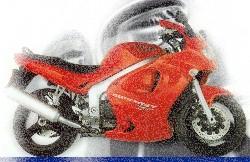
Cycle World
March 1999
ST portion and Conclusion from "GT Experience" article by Paul Seredynski - comparison of Duc ST4, BMW R1100S, Honda VFR800 Interceptor and Sprint ST.
Triumph Sprint ST
A combination of a new aluminum twin-spar frame and pieces from Triumph's improving parts bin, the new Sprint ST appears, on paper at least, to be a clearcut GT champ.
The new frame does an excellent job of cradling a slightly detuned version of Triumph's updated, 12-valve 955cc Triple from the 955i (formerly the T595 Daytona). Changes include different camshafts, redrawn fuel-injection mapping and an exhaust system that provides a broader torque curve. The Sprint also gets by with cast pistons and steel cylinder liners compared to the 955i's forged slugs and coated liners.
All the tuning for torque was successful. "This thing's got motor!" was the comment from Zerbel. Strapped to the CW dyno, the Sprint produced 100.4 horsepower, and 63.6 foot- pounds of torque, nearly identical to the Ducati (99.9 bhp, 61.2 ft-lbs.), but with a flatter torque curve. Thanks to\ that fat curve, which arrives just off idle and stays in until the engine signs off at rpm, the Triumph ruled in throttle response. In 60-80-mph roll-ons the Triumph eclipsed the second-fastest Ducati by .6 of a second (3.2 vs. 3.8 seconds).
The Sagem fuel-injection system, which benefits from the same updates made to the 955i, was seamless for a slight, low-speed hesitation most noticeable while trolling parking lots. Though it sounds like a Kenworth at idle, this engine is potent and very smooth, with the only gripes being that 1) the fun signed off too soon and 2) the Triple's snarl has been too heavily muzzled.
The new frame, while not as sexy as the Daytona's trade-mark oval-tube aluminum job, makes for a stable and light-steering package. The Sprint does share the 955i's single-sided aluminum swingarm, damped by a Showa shock adjustable for spring preload and rebound damping. The 43mm Showa fork provides only spring-preload adjustment. Nothing here steers as light as the Honda, but the Sprint came close, and was completely stable.
The Bridgestone BT57 radials offered tons of grip, and their rounded profile helped the Sprint roll easily into corners-so easily as to reveal limited cornering clearance and a slightly soft suspension. Like the Ducati, the Sprint features a two-position exhaust canister that can be rotated up to help increase cornering clearance when the optional hard luggage ($693) is removed. The system works, as the canister stayed off the pavement, but the right side of the fairing touched down early and often.
Otherwise, the Sprint was a treat in the twisties. Besides being completely neutral, the light steering allowed painless line adjustments mid-corner, and the engine felt so torquey that gear selection was more of a preference than a necessity. Brakes come straight off the 955i and work great, hauling the ST down from dumb speeds without drama.
so the Sprint ST is comfy, it's got a engine, great brakes, is put together well is functional. What's the rub? The gearbox. Most testers had a tough time with it, finding it and prone to false neutrals.
That is the only real flaw with this bike. It could use a little more cornering clearance, but if that means giving up that super-plush ride, it wouldn't be worth it. Minor nitpicks included mirrors that tended to flutter over 100 mph (the BMW's are dead-nuts solid at that speed), angled-in gauges that tended to pick up reflections, and an impressively sized gas tank (5.6 gallons) that's plastic, nixxing a magnetic tankbag (ditto the BMW).
In addition to the optional matching hard bags, a 45-liter tail case, heated grips, solo seat cowl and a tankbag, you can also opt for a factory performance silencer and reprogrammed injection mapping. The upgrade not only adds power, but brings the snarl of the Triple out of retirement.
The ST's subdued-if-classy styling will be called bland by many ("It looks like a Suzuki Katana," Canet offered), but there is no doubting Triumph has created a very impressive all-around performer, and at a tempting price. "World-class," is what Miles called the Sprint, "Triumph's best motorcycle yet."
Conclusion
So who's the GT King? For those most interested in sportbike performance, get the Honda. It's damn-near faultless, even if it lacks the torque and spaciousness of larger machines, and provides no option for integrated luggage. The Honda is also the least expensive bike in this comparison by $1000.
The Ducati is impressive, with bucketloads of engine character, and is amazingly entertaining as a sportbike or sport-tourer. But it's not the friendliest, nor the easiest to ride quickly, and it's expensive to purchase and maintain. The BMW is the long-haul king; those with a serious sport-touring bent will be thrilled. And when it comes time to head out solo on Sunday morning, there are plenty of grins to be had. It also looks the coolest, but ain't cheap.
Then you've got the Triumph, which may have been initially aimed at the VFR, but reminds more of the ST4. It is an incredibly comfortable motorcycle with serious grunt, a vice-free chassis and European flair at a decent price. The Sprint is equally happy in the twisties or on the interstate, even if the gearbox needs some work. It is not as polished or refined as the VFR, but nothing is.
We'd slap our money down on the Sprint ST with the optional canister and hard luggage. The Ducati and BMW are covetable pieces, but expensive. The Honda is an exceptional machine, but its comparative lack of torque and no hard lug-gage are disadvantages in this shootout. By a narrow poll, according to the GT formula we've laid out, the Triumph delivers the goods at a reasonable price. It's been a while, but we could get used to a British King.